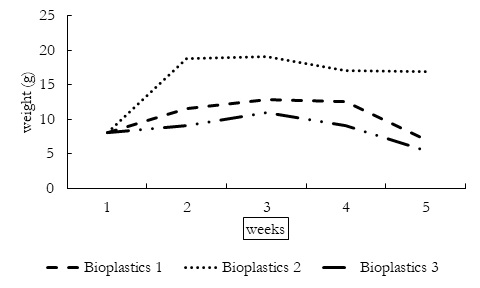Degradation of Bioplastics under the Influence of Several Environmental conditions
DOI:
https://doi.org/10.33411/ijist/2021030302Keywords:
Bioplastic, Degradability , Purified GlycerolAbstract
The increasing threats of plastics to the natural environment encouraged the production of bio-plastics from renewable biomass resources. The premium quality of bio-plastics are mainly produced by treating starch with glycerol. Plastics are basically non-biodegradable synthetic or semi synthetic products. This study aims at analyzing the degradation patterns of bio-plastics. The bio-plastics are ecologically less toxic than the synthetic plastic materials. The bio-plastics can degrade in several environmental conditions including aquatic environment, compost and soil. The bioplastic materials are buried in composite soil or loam sand to analyze degradation activity by taking photographic data and measuring the weight. Effect of weather conditions on the degradation activity was analyzed by recording different weather conditions including temperature, humidity, rainfall sunshine intensity and duration of sunlight. The comparative results portrayed the degradation activity of bio-plastics which was accomplished through hydrophilic enzymes. The initial regenerating material absorbs moisture of soil after saturation and the weight was increased up to 87%. The weight of bio-plastics reduced steadily after the initiation of decomposition. Invasion of soil microorganisms enhance the degradation activity. The environmental features including rainfall, humidity and sunlight intensity also affects the disintegration of bioplastics. The increased intensity of sunshine increased the microbial activity of soil which in turn increased the rate of degradation of bio-plastics.
References
Crawford, C.B. and Quinn, B. Plastic Production, Waste and Legislation. In: Crawford, C.B. and Quinn, B., Eds., Microplastic Pollutants, Elsevier Science, Amsterdam,pp:39-56,2017.
Mark, H.F. and Bikales, N.M. Degradation. In: Encyclopedia of Polymer Science and Technology, John Wiley & Sons, Inc., Hoboken, pp: 1-44, 2005.
Gross, M. Plastic Waste Is All at Sea. Current Biology, Vol 23, issue 4, pp: R135-R137, 2013.
Jambeck, J.R., Geyer, R., Wilcox, C., et al. Marine pollution. Plastic waste inputs from land into the ocean, Science, Vol 347, issue 6223, pp: 768-771, 2015.
Derraik, J.G.B. The Pollution of the Marine Environment by Plastic Debris: A Review. Marine Pollution Bulletin, Vol 44, issue 9, pp: 842-852, 2002.
Webb, H.K., Arnott, J., Crawford, R.J. and Ivanova, E.P. Plastic Degradation and Its Environmental Implications with Special Reference to Poly(ethylene terephthalate). Polymers (Basel), Vol 5, issue 1, pp: 1-18, 2013.
Demirbas, A. Biodegradable Plastics from Renewable Resources. Energy Sources, Part A: Recovery, Utilization, and Environmental Effects, Vol 29, issue 5, pp: 419-424,2007.
Lorcks, J. Properties and Applications of Compostable Starch-Based Plastic Material. Polymer Degradation and Stability, Vol 59, pp: 245-249, 2002.
Sagnelli, D., Hebelstrup, K.H., Leroy, E., et al. Plant-Crafted Starches for Bioplastics Production. Carbohydrate Polymers, Vol 152, issue 5, pp: 398-408, 2016.
Ashter, S.A. Types of Biodegradable Polymers. In: Ashter, S.A., Ed., Introduction to Bioplastics Engineering, William Andrew, Amsterdam, Vol 8, issue 4, pp: 81-151, 2016.
Zhou, X., Yang, R., Wang, B. and Chen, K. Development and Characterization of Bilayer Films Based on Pea Starch/Polylactic Acid and Use in the Cherry Tomatoes Packaging. Carbohydrate Polymers, pp: 222, 2019.
Harma, A.K. Biopolymers in Drug Delivery. Biopolymers Research, Vol 1, issue 1, pp: 1-2,2017.
Shah, A.A., Hasan, F., Hameed, A. and Ahmed, S. Biological Degradation of Plastics: A Comprehensive Review. Biotechnology Advances, Vol 26, issue 3, pp: 246-265,2008.
Müller, C.M.O., Laurindo, J.B. and Yamashita, F. Composites of Thermoplastic Starch and Nanoclays Produced by Extrusion and Thermopressing. Carbohydrate Polymers, Vol 89, issue 2 pp: 504-510,2012.
Singh, J., Dartois, A. and Kaur, L. Starch Digestibility in Food Matrix: A Review.
Trends in Food Science & Technology, Vol 21, issue 4, pp: 168-180, 2010.
Emadian, S.M., Onay, T.T. and Demirel, B. Biodegradation of Bioplastics in Natural Environments. Waste Management, Vol 59, pp: 526-536, 2017.
Nuwamanya, E., Baguma, Y., Wembabazi, E. and Rubaihayo, P. Comparative Study of the Physicochemical Properties of Starches from Root, Tuber and Cereal Crops. African Journal of Biotechnology, Vol 10, issue 56, pp; 12018-12030, 2011.
Nanda, M., Yuan, Z., Qin, W., Poirier, M.A. and Xu, C. Purification of Crude Glycerol Using Acidification: Effects of Acid Types and Product Characterization.
Austin Journal of Chemical Engineering, vol 1, issue 1, pp: 1004, 2015.
Abolibda, T.Z. Physical and Chemical Investigations of Starch Based Bio-Plastics. Thesis, University of Leicester, Leicester, Vol 29, Vol 479, pp: 2-29, 2015.
Smirnova, J., Fernie, A.R. and Steup, M. Starch Degradation. In: Nakamura, Y., Ed., Starch: Metabolism and Structure, Springer, Berlin, pp: 239-290, 2015.
Rudnik, E. and Briassoulis, D. Degradation Behaviour of Poly (lactic acid) Films and Fibres in Soil under Mediterranean Field Conditions and Laboratory Simulations Testing. Industrial Crops and Products, Vol 33, pp: 648-658, 2011.
Fettke, J., Hejazi, M., Smirnova, J., Hochel, E., Stage, M. and Steup, M. Eukaryotic Starch Degradation: Integration of Plastidial and Cytosolic Pathways. Journal of Experimental Botany, Vol 60, issue 10, pp: 2907-2922, 2009.
Hoshino, A., Sawada, H., Yokota, M., Tsuji, M., Fukuda, K. and Kimura, M. Influence of Weather Conditions and Soil Properties on Degradation of Biodegradable Plastics in Soil. Soil Science and Plant Nutrition, Vol 47, issue 1, pp: 35-43, 2001.

Published
How to Cite
Issue
Section
License
Copyright (c) 2021 International Journal of Innovations in Science & Technology

This work is licensed under a Creative Commons Attribution 4.0 International License.




















